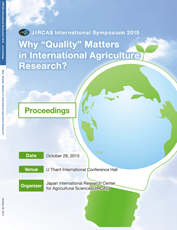Uses of Non-Timber Forest Products in Lao PDR and their values

Agriculture in Laos is primarily rain dependent due to its tropical monsoon climate. Farmlands are
often subjected to droughts and floods, rendering crop production unstable. Therefore, in addition to rice
cultivation, Laotian farmers collect non-timber forestry products (NTFPs) in mountainous areas, thus
providing a safety net to local residents in terms of livelihood support. However, the way NTFPs are used had
changed because of deforestation and forest degradation. The actual uses of forest resources by Laotians were
elucidated through a social survey and a forest vegetation survey.
To understand the actual uses of NTFPs and its contribution to rural household economies, a study was
conducted on 140 households (104 valid responses) in a farming village (N village) in the northwestern
part of Vientiane Province from July 2012 through June 2013, recording the types and quantities of NTFPs
collected daily as well as their intended uses. The consumption of firewood, which was excluded from
NTFPs, was determined in 10 farm households from February 2013 to January 2014. The obtained values
were compared with that of rice production, which is their basic means of livelihood. In order to categorize
the type of forests producing NTFPs, a forest survey was conducted.
The survey showed that over 400 diverse types of NTFPs, including 289 plant-type products (such as
mushrooms) and 124 animal-type products, were utilized. Over 90 percent of NTFPs were mostly consumed
as food by the collecting households. Other NTFPs, which were categorized as textiles, resins, and medicines,
were collected for sale; and these include approximately eight tons (dry weight) of textiles. Most of these
NTFPs were broom grass, from which flower clusters are collected and used for making products such as
brooms. Broom grass appears in fallow land after slashing and burning and can be collected in large quantities
during the first three years. It is also a valuable source of income between periods of farming. Firewood was
used at an average of 2,258 kg per year, which was equivalent to 1,700,000 Kip when converted to cash.
The economic value of NTFPs was estimated at approximately 7,000,000 Kip (3,820,000 Kip from plant
types, 1,660,000 Kip from animal types and 1,700,000 Kip from firewood). This equates to approximately
2.4 tons of glutinous rice, enough to feed 9.6 people (at 250 kg/person/year) and contributes greatly to the
rural economy. The economic value of NTFPs when compared with that of rice farming is equivalent to rice
production in 0.5 ha of paddy field or 1.5 ha of upland field. Almost all forests in the N Village were fallow
(secondary) forests. At first, it was thought that a young fallow forest produces only a few useful NTFPs.
However, villagers were able to collect high volume of NTFPs in various kinds from the forests, with an
economic value equivalent to that of rice production.
It is important to utilize the upland fields in the mountainous area in order to increase income of the
villagers. To position the forests fairly within the economic system of the village is very important for the
livelihood of local people.
| Date of issued | |
|---|---|
| Creator | Kenichiro Kimura |
| Subject |
economic value NTFPs (Non-timber forest products) sustainable food security fallow forest |
| Publisher | Japan International Research Center for Agricultural Sciences |
| Available Online | |
| Issue | 2015 |
| spage | 98 |
| epage | 104 |
| Rights | Japan International Research Center for Agricultural Sciences |
| Language | eng |
